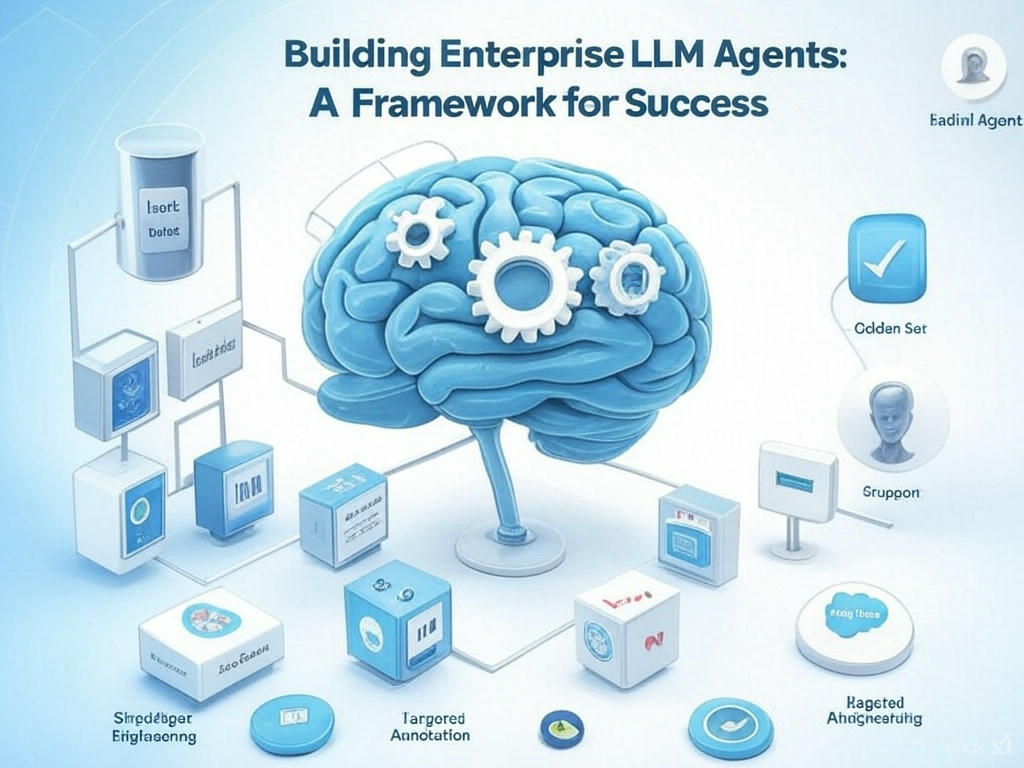Building Enterprise LLM Agents: Frameworks, Strategies, and Best Practices
Large Language Model (LLM) agents are transforming enterprise operations by enabling advanced language understanding, reasoning, and automation across various domains. These AI-powered systems excel in tasks like customer support, workflow automation, decision-making, and information retrieval. However, building scalable, safe, and efficient LLM agents for enterprise use is a complex challenge. Here’s a detailed guide on the frameworks, strategies, evaluation methods, and failure mitigation techniques for deploying enterprise-grade LLM agents.
Frameworks for LLM Agents
The choice of framework significantly impacts the scalability and performance of LLM agents. Popular frameworks include LangChain, AutoGen, and Crew AI, each with unique strengths based on the use case:
- LangChain: Ideal for large-scale enterprise agents requiring high observability and debugging capabilities.
- AutoGen: Best suited for quick tests or proof-of-concept projects due to its low setup cost and ease of integration.
- Crew AI: Useful for orchestrating pre-built tools in multi-agent setups.
Key criteria for selecting a framework include:
- Observability: Ensuring easy debugging and issue resolution.
- Setup Cost: Minimizing time to iterate and build.
- Support: Availability of robust documentation and compatibility with various tools.
Framework selection should align with the specific requirements of the use case while considering the evolving landscape of LLM development.
Strategies for Implementation
When deploying LLM agents, developers must decide between single-agent or multi-agent strategies:
Single-Agent Approach
- Recommended for simplicity and ease of management.
- Focus on tool specification by providing clear instructions and examples to minimize confusion.
- Simplify input types (e.g., converting complex nested dictionaries into simpler data types like lists or floats).
- Cache chat histories to improve performance over time while avoiding hallucinations caused by long conversations.
Multi-Agent Approach
- Involves multiple agents working together with a routing model to manage tasks.
- Requires clear descriptions of tools and well-defined routing instructions to handle edge cases effectively.
- Sub-agents should be constrained to specific tasks with limited tools to ensure accuracy.
Safety Considerations
Safety is paramount in enterprise applications. Autonomous LLM agents must incorporate mechanisms like human-in-the-loop (HITL) feedback to prevent unintended actions. For example:
- In a Gmail agent, request user confirmation before sending emails.
- Codify rules that trigger HITL under specific conditions (e.g., before or after tool calls).
This ensures that sensitive actions are reviewed before execution, enhancing trust and reliability.
Evaluation Methods
Evaluating an LLM agent involves assessing its ability to make accurate tool calls, reason over results, and deliver correct outputs. Key evaluation practices include:
- Golden Set Creation: Develop a dataset of expected inputs, outputs, tool calls, and parameters to benchmark agent performance.
- Intermediate Stage Analysis: Monitor all stages of reasoning and decision-making to identify failure points.
- Debugging Tools: Use observability features in frameworks like LangChain to track agent behavior at every step.
Failure Mitigation Strategies
Failures are inevitable in autonomous systems. Effective mitigation strategies depend on the severity of the issue:
- Low Failure Rate:
- Use prompt engineering to refine API specifications or tool inputs.
- Moderate Failure Rate (10–20%):
- Build targeted annotation datasets to address specific task failures.
- High Failure Rate:
- Generate synthetic data for fine-tuning models when dealing with complex APIs or ambiguous tool names.
Enterprise Applications
LLM agents are revolutionizing industries by automating workflows, improving decision-making, and enhancing user interactions. Common use cases include:
- Customer Support:
- Handle FAQs, troubleshoot issues, and provide 24/7 assistance.
- Sales Automation:
- Qualify leads, personalize follow-ups, and analyze market trends.
- Internal Support (HR & IT):
- Streamline employee inquiries about policies or technical issues.
Final Thoughts
Building enterprise LLM agents requires careful consideration of frameworks, strategies, safety mechanisms, evaluation methods, and failure mitigation techniques. By leveraging advanced tools like North and following best practices outlined above, organizations can unlock the full potential of LLM agents to drive innovation and efficiency in their operations.
